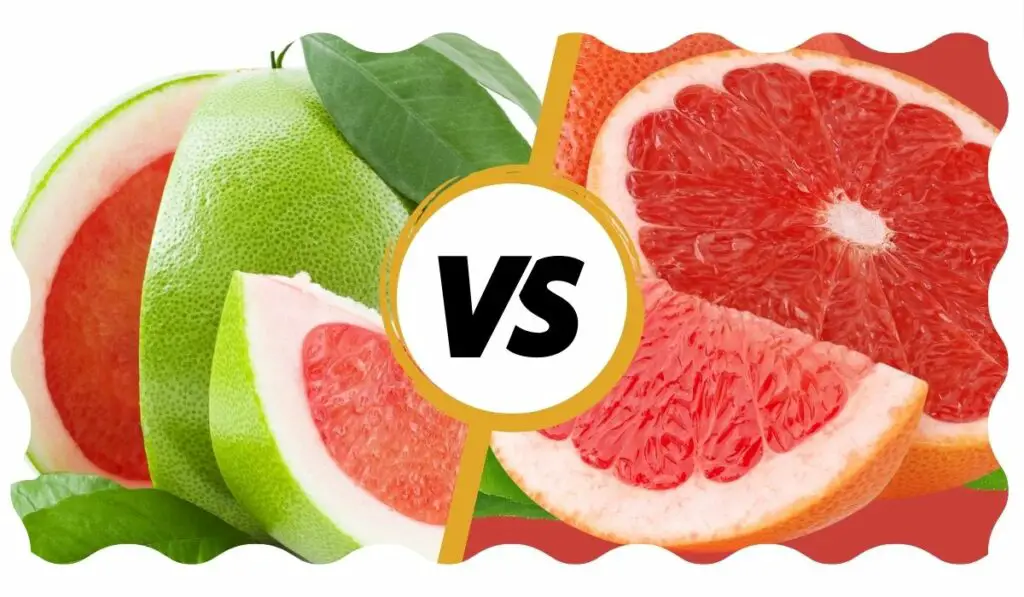
Have you ever been in a fruit market, seen a grapefruit and a pomelo side by side, and wondered if they were the same fruit?
Grapefruit and pomelo are not the same, though they belong to the same citrus family. While they share certain characteristics, they differ in their origins, taste, size, and nutritional profile. It’s essential to distinguish between the two to understand their unique qualities and uses.
In the coming sections, we’ll explore the origins of these fruits, the distinctions in their appearance and taste, and their nutritional benefits.
Origins and History of Grapefruit and Pomelo
The world of citrus fruits has a rich and intricate history, with grapefruit and pomelo being key players in this narrative.
Grapefruit
Grapefruit, known scientifically as Citrus × paradisi, has a surprisingly recent origin in the grand tapestry of fruit history. The grapefruit is believed to be a natural hybrid that spontaneously originated in Barbados in the 17th century. It was a result of accidental cross-pollination between the pomelo (Citrus maxima) and the sweet orange (Citrus sinensis). The name “grapefruit” is a nod to the way the fruit grows in clusters on trees, somewhat reminiscent of grape bunches.
Interestingly, grapefruit was initially called the “forbidden fruit” of Barbados. It made its way to the United States in the early 19th century, with Florida becoming a major producer by the late 19th century. Today, it’s not only cultivated for its tangy and refreshing fruit but also for its essential oil and as an ornamental tree.
Pomelo
Often referred to as the “ancestor” of many citrus varieties, pomelo, or Citrus maxima, has roots that trace back thousands of years. Native to Southeast Asia, particularly Malaysia, the pomelo has been cultivated and consumed in regions like China, Thailand, and Indonesia for over 4,000 years. In ancient Chinese culture, pomelos were a symbol of prosperity and good fortune, often being used in rituals and ceremonies.
The skin of the pomelo was traditionally used in various cultures for its medicinal properties, particularly for ailments like coughs or ulcers. Moreover, its thick, soft rind made it a popular ingredient in preserves and candies.
Through the ages, as trade routes expanded, the pomelo found its way to different parts of the world, contributing its genes to the birth of new citrus varieties, such as the aforementioned grapefruit.
Appearance and Taste Differences
We have broken the section into simple tables to differentiate grapefruit and pomelo appearance and taste.
| Feature | Grapefruit | Pomelo |
|---|---|---|
| Size | Similar to a softball | Can be as large as a basketball |
| Color | Pink, red, or white flesh | Pale green or yellow skin; white, pink, or red flesh |
| Taste | Sweet with a bitter undertone | Milder and sweeter with a tangy edge |
Nutritional Benefits and Uses
Both grapefruit and pomelo offer a wealth of nutrients. They’re rich in vitamin C, fiber, and antioxidants. However, grapefruit has a slightly higher concentration of vitamins A and C, while pomelos provide a tad more fiber.
When it comes to usage, both fruits are versatile. They can be eaten fresh, juiced, or even included in salads and desserts. However, due to the grapefruit’s bitter taste, it often pairs well with sweet dishes or with a sprinkle of sugar. Pomelo, being milder, can be enjoyed with a pinch of salt or mixed with spicy ingredients in salads.
Can You Eat a Pomelo Like a Grapefruit?
Navigating the world of citrus fruits can be an adventure in itself. I recall the first time I tried a pomelo, expecting it to be just like an oversized grapefruit. The experience was different but delightful. If you’ve ever wondered how to approach eating a pomelo compared to a grapefruit, let’s break it down.
Texture & Flavor
First things first, the bite. Pomelo has a drier, more solid pulp than the softer, juicier grapefruit. Imagine biting into a slightly firm watermelon versus a ripe peach. That’s the kind of contrast we’re talking about. Grapefruit has that unmistakable tart kick, especially in the white and pink varieties. Pomelos? They’re your gentle friend, sweeter and less likely to make you pucker, with a hint of a floral note that always reminds me of spring mornings.
Eating Methods
I learned this the slightly messy way: While you can slice a grapefruit in half and go to town with a spoon (I love a sprinkle of sugar on mine on chilly mornings), pomelos require a different approach. That thick, almost helmet-like rind? It’s there for a reason. Start by cutting off the top and making slight slits vertically. Then, enjoy the satisfaction of peeling it away, much like unwrapping a present.
You’ll find large segments inside, reminiscent of grapefruit but with a thicker protective skin. My grandma always advised peeling away this skin – it’s a bit bitter. But the treasure inside is sweet and succulent.
Tip: Keep a napkin handy when peeling a pomelo; the juice, while not as abundant as grapefruit, can be a surprise!
Incorporating into Dishes
Once I discovered the joy of adding citrus to my meals, there was no turning back. Grapefruit, with its tangy zing, beautifully brightens up a grilled chicken salad. Meanwhile, pomelo, with its gentler taste, became my go-to for Asian-inspired salads. Imagine pomelo chunks, tossed with grilled shrimp, toasted peanuts, and a drizzle of spicy-sweet dressing. Heaven!
Personal Tip: If you’re trying pomelo for the first time, enjoy it in its pure form before mixing it into dishes. It’s the best way to appreciate its unique flavor profile.
Also Read:
Conclusion
Grapefruit and pomelo are distinct fruits. Though closely related, grapefruit and pomelo stand out in their unique ways. From their distinct origins and histories to their differences in appearance, taste, and nutritional profile, it’s clear that these fruits each bring something special to the table.
